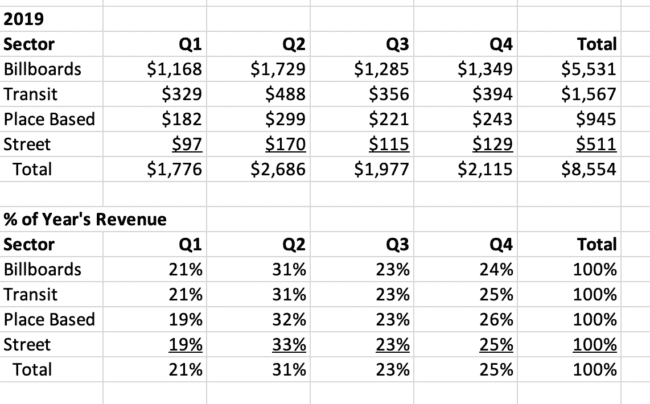A reader asked Billboard Insider if out of home revenues are seasonal. The answer is yes, with a peak in the second and fourth quarter of each year. Look at this analysis of US out of home revenues for 2019 (the last full year prior to covid)
US Out of Home Quarterly Revenues for 2019 (million dollars)

- Out of home revenues are seasonal with a peak in the second and fourth quarter each year. The second quarter accounted for 31% of US 2019 out of home revenues. OOH Capital Partner Stephen Freitas tells, ” This is actually the common trend. Second quarter is when people are ready to go out and about emerging from a long winter at home. Baseball, roadtrips, and beer ads.” Steve Nicklin, the OAAA’s VP in charge of Marketing Insights and Analytics adds: “The change in the weather between the first and second quarters is obviously a big driver, because it dictates “out of home” consumer behavior and OOH advertising spend. According to Kantar, the Beer & Wine category placed 38% of its annual OOH spend in Q2 2019. Other categories with spike spending in the second quarter are restaurants, travel and tourism, and automotive (both manufacturer and dealer). Kantar also shows a slight spike for the Government, Politics and Organizations category which is reflective of the political season primary calendar.”
- Revenues are lowest in the first quarter of each year. First quarter revenues accounted for only 21% of US 2019 out of home revenues. “First quarter is always the softest,” says Freitas, “the holiday season has just wrapped up and the gifts have been given. People tend to stay closer to home during the cold winter months so brands often decrease ad budgets saving more dollars for the warmer months. This fact actually makes the first quarter an ideal time for savvy brands to advertise since there is less competition for prime media placements.”
- Seasonality is more pronounced for place paced ads and street furniture.
Insider’s Take: Seasonality means you need to compare quarterly out of home revenues against the prior year’s quarter not against the prior calendar quarter. Second quarter revenues may be up 50% against the first quarter simply because of seasonality.
[wpforms id=”9787″]
Paid Advertisement

















